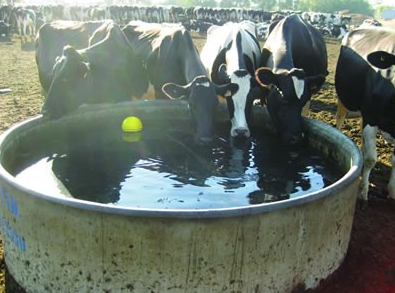Keeping your cows (and other livestock) cool!
 PRODUCTION ADVICE - DECEMBER 2020 - ANIMAL BIOSECURITY & WELFARE
PRODUCTION ADVICE - DECEMBER 2020 - ANIMAL BIOSECURITY & WELFARE
By Adrian Smith
Senior Land Services officer - Mixed Farming Systems
P: 03 5881 9932 | M: 0447 778 515 | E: adrian.smith@lls.nsw.gov.au
The subject of this article is high-producing dairy cows. However, the general concepts are broadly applicable to all livestock – with some obvious considerations around the practicality of some of the management actions producers can implement.
With the prospect of another long, hot (and perhaps humid) summer in front of us, what can you do to minimise the impacts on your cows?
Heat stress can have a very significant impact on your dairy cows, and ultimately your farm income. Heat stress can:
- reduce milk production by up to 40 per cent in severe cases (and this lower production can last for several weeks)
- reduce milk protein and fat tests
- reduce feed intake, with impacts on body condition
- impact cow health and fertility
- increase the risk of diseases such as mastitis.
Dairy Australia has an excellent publication ‘Cool Cows – strategies for managing heat stress in dairy cows’. This is part of their highly successful ‘Cool Cows’ program.
The booklet provides a wealth of information to allow dairy producers to recognise the signs and effects of heat stress. It also gives strategies that can reduce its impact.
While industry has a good handle on the impacts of hot weather on dairy production, a joint project between Dairy Australia, Gardiner Dairy Foundation and Agriculture Victoria - the Feeding Cool Cows project - aims to develop strategies to offset reductions in feed intake by identifying diet ingredients that help cows maintain intake or offset the effect of reduced intake on milk production. If producers are interested in finding out more, contact Murray Dairy.
Whilst we might associate heat stress with temperatures above 40oC, even at temperatures above 25oC, cows begin to feel uncomfortable, and will burn energy to keep cool.
Did you know the main form of cooling used by cattle is sweating? Sweating is responsible for 70 per cent of the heat loss from cattle with the other 30 per cent mainly from breathing, with a small amount lost from the skin and saliva.
So, anything that can be done to help cows lose heat through evaporative processes is worthwhile. Remember that increasing humidity (particularly in the absence of air movement) can significantly increase the impacts on your cows.
What can you do to monitor and implement strategies to reduce the impacts of heat stress?
- Monitor cows’ breathing rate – 40-60 breaths/minute is normal, above 60 indicates the cow’s core body temperature is above 39oC, and above 70 indicates significant stress. 90-100 breaths/minute can result in cow death.
- Use forecasts and other tools to anticipate the onset of adverse conditions – refer to the Cool Cows website (coolcows.com.au) to help monitor weather conditions.
- Provide shade – shade is your best friend in hot conditions. It can reduce radiant heat loads by more than 50 per cent.
- Provide cool, clean water. High-producing cows may consume up to 250 litres of water per day in hot conditions. The greater the difference in temperature between the environment and the water, the better the result.
- Sprinklers and fans
- Use sprinklers to wet down and cool concrete before cows arrive at the dairy.
- Heat loss from a wet cow increases three-fold when airflow increases.
- Minimise walking time
- Take feed to cows sheltering from heat
- Modify milking times – milk as early as possible in the morning, and after 5pm in extreme conditions.

Access to cool, clean water is essential to reduce the impacts of heat stress in dairy herds. Photo courtesy of Dairy Australia.
Other basic principles to remember are:
- Flow rate to troughs is more important than the capacity (volume) of the trough – although cows do seem to prefer larger troughs.
- Don’t run black polypipe to troughs along the ground.
- Ideally place troughs in shaded areas.
- Place troughs away from feed.
- Troughs should be cleaned frequently – drainage water needs to be directed away from the trough.
There are many other things that you need to take into account with extreme heat events, including nutrition, mating and heat detection, cow (and herd) health and changes to your milking schedule.
Both short- and long-term planning are essential to minimise the impacts of heat stress. Monitor your cows, implement short-term options such as wetting down yards and providing sprinklers. In the long term, develop a plan to improve access to shade, provide adequate access to cool, clean water, and install fans in the milking shed.
In our environment, heat stress can have significant impacts on cow health and performance, and on your financial performance as a dairy producer. Investing in keeping your cows cool will have a significant pay-off.
For further information, producers are encouraged to review the information provided in the ‘Cool Cows’ publication, available from Dairy Australia and Murray Dairy, and speak with your farm advisors.